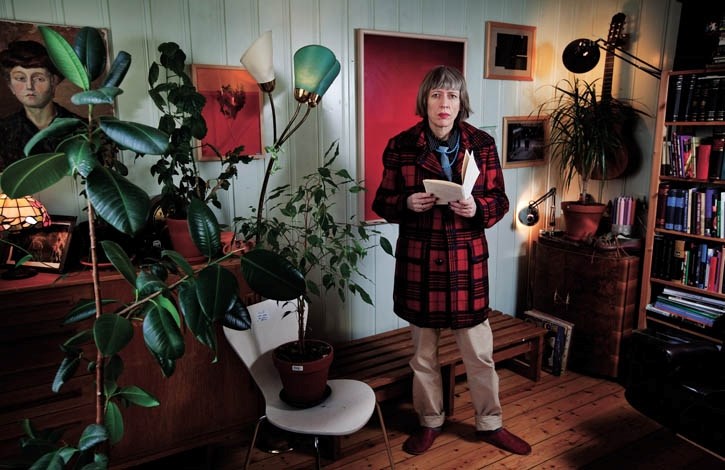Icelandic author Kristín Ómarsdóttir has come to the wilderness seeking inspiration.
“It’s an unbelievable place,” she said. “It’s so different from where I come from. I don’t know forest life, I don’t know animals, so this is something very new to me in every aspect. It’s fairytale-like.”
Ómarsdóttir is an author in her homeland of books, short stories and poetry. For the month of May, she is at The Banff Centre as part of the Benediktson Fellowship for Icelandic Artists, which began in 2009 with the support of the Government of Iceland.
The fellowship supports a creative residency at centre for an Icelandic artist every year, and Ómarsdóttir is the second. The first was visual artist Ragnar Kjartansson, who created a piece in Banff for the Venice Biennale.
Stephen Benediktson, the donor, is a Calgary-based philanthropist whose grandfather, Stephan G. Stephansson, homesteaded west of Red Deer, and was a poet whose work is still widely read in Iceland. Stephansson’s homestead is a recognized provincial historic site. Stephen Benediktson created this fellowship in celebration of his grandfather’s life and writing, and to build a stronger creative tie between Iceland and Alberta.
Ómarsdóttir describes her style of writing as being like a robot.
“I’m a little bit of a robot,” she said. “I read some stuff, and look into some matters and subjects, and when I’ve done so, I start writing and I have the self image of a robot.
“A robot doesn’t know what it’s doing, it just does it. It just writes. I jump into the river, fish up some stories and write them.”
Her first publication was a book of poetry, Í húsinu okkar er ţoka (There is Fog in Our House) in 1987 and her first novel, Svartir brúđarkjólar (Black Wedding Dresses), was published in 1992.
“I’ve written one story about war, one story about an artist in the city, one about a tourist travelling somewhere far, far away, and one is about a family of brothers living on the edge of the world, where it’s the end of life, a very isolated place left behind,” she said, describing her work.
“I wrote a play about a city in the future where there’s very strict rules for everything, concentrating on making the perfect man,” she explained. “I wrote a play about a family where the wife is married, linked to old Icelandic stories about sea people, who come to live with human beings, and about having a mermaid for a mother.
“I also write poems, they collect themselves into groups. Poetry about living in Iceland at the beginning of the 21st century, an unknown place where it’s warm and a different atmosphere. Nostalgic poetry about lost worlds.”
Ómarsdóttir has received a number of awards for her work. The play Draumar á hvolfi (Dreams, Up Side Down) won first prize in the National Theatre competition to mark the completion of the women’s decade in 1985; the novel Elskan mín ég dey (I’ll Die, My Love) recieved the DV Cultural Prize for literature in 1998; and two of her novels have been nominated for the Icelandic Literature Award. Her play, Ástarsaga 3 (Lovestory 3), staged in The Reykjavík City Theatre in 1997, was nominated for the Nordic Council Drama Award.
Ómarsdóttir has also worked with other artists, such as photographer Nanna Bisp Büchert. Together they made the book Sérstakur dagur (A Special Day), where photographs and poems work together. She has made the video artwork for The Secret Life of Icelanders, in cooperation with poet and artist Haraldur Jónsson, which was shown in galleries around Europe and the United States in 1996.
In October, 2003 Ómarsdóttir published a bilingual book Inn og út um gluggann (In and out the window), with poems in Icelandic and English, and pictures by artists Anna Hallin and Ósk Vilhjálmsdóttir. Books by Ómarsdóttir have been translated into other languages, and her poetry has appeared in collections around the world.
As for what she is working on here in Banff, Ómarsdóttir would not say.
“It’s difficult to talk about that,” she said. “I will not tell my best friend about it, but I’m almost going to tell you it, but it’s better I don’t tell.
“I’m concentrating on novels now, I have some novels I have to finish, that I’ve been working on for quite a while. Some stuff that has been on my mind for 10 years and I’m still hooked on this subject.”
The relaxed atmosphere of the national park is helping with her work, said Ómarsdóttir.
“I find inspiration in Banff, peace and quiet, tranquility, which is hard to find in Reykjavík nowadays, because we have a very sensitive situation in politics and everything,” she explained. “Some want Iceland to become very industrialized, others want to open up the Earth for every possibility, and others don’t want that.
“The (government) privatized the sea 15 years ago. There is a sailor heart inside almost everybody and many want the nationalization of the sea again. It’s a mutual national resource, not something which is owned by a few people, which it is now.
“People cannot go and fish as they like and the fish is very expensive, but it used to be our main food which we could afford, and now we can’t.”




